Preventing diarrhea in goats often involves good management practices. Ensure that goats have access to clean, uncontaminated water and high-quality feed. Regular deworming protocols and vaccinations can help reduce the risk of infectious causes. Additionally, minimizing stress through proper housing, reducing overcrowding, and gradually introducing diet changes can help maintain a healthy herd.



